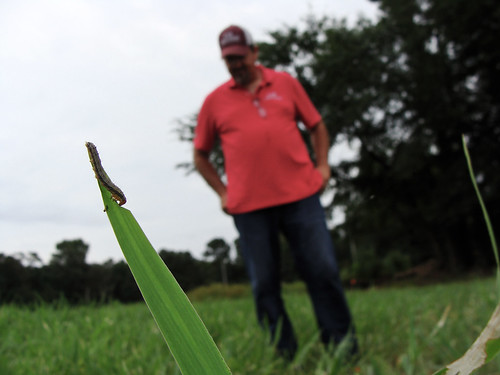Extension demo plot shows most economic management tool during heavy fall armyworm year
By Mary Hightower
U of A System Division of Agriculture
Aug. 3, 2017
Fast facts:
- Pyrethroid, chlorantraniliprole combo shows effective, long-term control of fall armyworms
- Fall armyworms appeared early in 2017, with overlapping generations
(702 words)
(Download this story in MS Word here.)
NEAR STAR CITY, Ark. – Fall armyworms don’t bother with calendars. They’re here, they’re hungry and – never mind that it’s mid-summer – they’re in their second generation.
However, they can be managed, and that’s what Kelly Loftin, extension entomologist, and Hank Chaney, regional agricultural and natural resources specialist, have been working with Steven Stone, Lincoln County extension staff chair, all with the University of Arkansas System Division of Agriculture, have been eager to show in a pasture outside of Star City in southeastern Arkansas.
From afar, the differences are noticeable. Large patches of dark green bordering a patch of pasture that looks like it was still covered in dew or frost. Upon closer examination, the differences are stark. Patches were what’s left of the bermudagrass has been chewed to the dirt by two generations of fall armyworms. Caterpillars of all sizes stretched along remaining blades of other types of grass or were curled up in little O shapes in the dirt.
In another part, the Bermudagrass was green and growing. There were a handful of armyworm caterpillars – most were on the small side. Some were dying or already dead.
The difference? The whole pasture was sprayed in early July with one of two insecticides. One part of the pasture was sprayed with a pyrethroid – lambda-cyhalothrin – the other with a combination of lambda-cyhalothrin and chlorantraniliprole, known commercially as Besiege®.
Loftin said by mid-June this year – even before summer started – fall armyworms were well above treatment threshold. They were appearing in mixed sizes, an indication of overlapping generations.
“With overlapping generations, reinfestation is common and may result in significant yield losses or the need to make multiple insecticide applications,” he said. “Last year some of our producers had to make three, and a few had to make four insecticide applications to make their hay crop.”
While pyrethroids, such as lambda-cyhalothrin, are effective and are frequently used to control fall armyworms in pastures and hay fields, they don’t have staying power.
Side-by-side comparison
This year, Loftin, Stone and extension area agricultural and natural resources specialist teamed with Laco Farms, for a six-acre demonstration comparing of armyworm management methods.
Laco, owned by Alton Mitchell, is a family farm with poultry, hay and cattle.
“Mr. Mitchell called me when he found armyworms and was concerned about what product to use,” Stone said. Mitchell agreed to host a demonstration plot because “he was going to treat it anyway and was interested in seeing the results.”
Stone said Mitchell’s son-in-law told him they hadn’t had this problem 15 years ago and asked what changed. Stone said the Mitchells’ improved hay production practices made “their grass more attractive to the armyworms. A pasture full of weeds is not going to have an armyworm. The insects pick the best, most attractive grass and that’s where they lay their eggs.”
What they found
What they found is that both Besiege and the generic pyrethroid lambda-cyhalothrin reduced armyworm populations to zero three days after treatment, with the untreated plot averaging 1.2 worms per square foot – holdovers from the initial infestation. The populations were still at zero for both at seven days after treatment.
However, at 17 days post-treatment, the fall armyworms came back. The areas treated with Besiege averaged less than one worm per square foot, while populations crept up to almost nine worms per square foot in the generic pyrethroid areas.
At 21 days after treatment, of the 10 sampled areas in the Besieged treated pasture, only a single armyworm was found. In the generic pyrethroid area, the 10 sampled spots averaged 13 worms per square foot. A control area, left untreated, averaged 8.9 worms per square foot.
“In this specific case, one spray application would have been eliminated by using a product with long residual activity,” Loftin said. “When choosing a treatment option to control fall armyworms in pasture, always consider the product cost per acre, the labor and fuel cost per acre, grazing and/or harvest restrictions and maturity of hay crop.
“The cost in labor and fuel, estimated at about $5, is often overlooked when choosing treatment options,” Loftin said. “Stay tuned - additional evaluations will be made at 28 days after treatment.”
Mention of commercial products does not imply endorsement by the University of Arkansas System Division of Agriculture.
For more information about pest management, contact your county extension office or visit http://arkansascrops.com or uaex.uada.edu.
About the Division of Agriculture
The University of Arkansas System Division of Agriculture’s mission is to strengthen agriculture, communities, and families by connecting trusted research to the adoption of best practices. Through the Agricultural Experiment Station and the Cooperative Extension Service, the Division of Agriculture conducts research and extension work within the nation’s historic land grant education system.
Pursuant to 7 CFR § 15.3, the University of Arkansas System Division of Agriculture offers all its Extension and Research programs and services (including employment) without regard to race, color, sex, national origin, religion, age, disability, marital or veteran status, genetic information, sexual preference, pregnancy or any other legally protected status, and is an equal opportunity institution.
# # #
Media Contact: Mary Hightower
Dir. of Communication Services
U of A System Division of Agriculture
Cooperative Extension Service
(501) 671-2126
mhightower@uada.edu
Related Links
